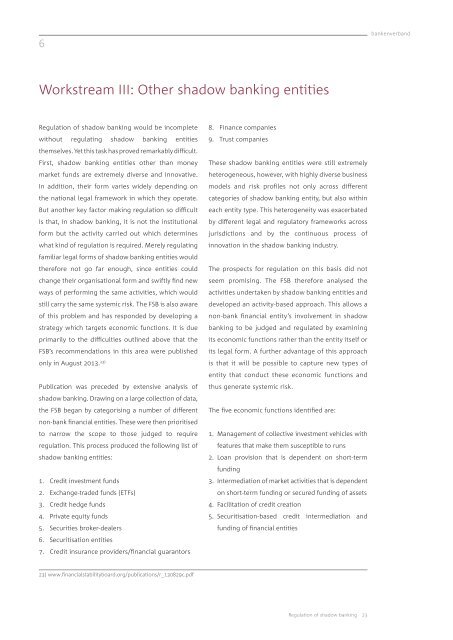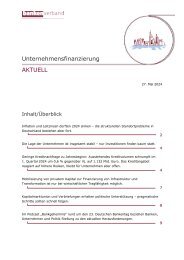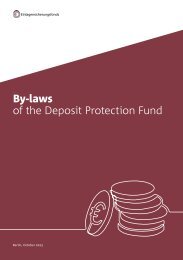Regulation of shadow banking
Shadow banking is given a large share of the blame for the financial crisis. This perception raises the question of what kind of shadow banking system should remain in place in the future.
Shadow banking is given a large share of the blame for the financial crisis. This perception raises the question of what kind of shadow banking system should remain in place in the future.
Create successful ePaper yourself
Turn your PDF publications into a flip-book with our unique Google optimized e-Paper software.
6<br />
bankenverband<br />
Workstream III: Other <strong>shadow</strong> <strong>banking</strong> entities<br />
<strong>Regulation</strong> <strong>of</strong> <strong>shadow</strong> <strong>banking</strong> would be incomplete<br />
without regulating <strong>shadow</strong> <strong>banking</strong> entities<br />
themselves. Yet this task has proved remarkably difficult.<br />
First, <strong>shadow</strong> <strong>banking</strong> entities other than money<br />
market funds are extremely diverse and innovative.<br />
In addition, their form varies widely depending on<br />
the national legal framework in which they operate.<br />
But another key factor making regulation so difficult<br />
is that, in <strong>shadow</strong> <strong>banking</strong>, it is not the institutional<br />
form but the activity carried out which determines<br />
what kind <strong>of</strong> regulation is required. Merely regulating<br />
familiar legal forms <strong>of</strong> <strong>shadow</strong> <strong>banking</strong> entities would<br />
therefore not go far enough, since entities could<br />
change their organisational form and swiftly find new<br />
ways <strong>of</strong> performing the same activities, which would<br />
still carry the same systemic risk. The FSB is also aware<br />
<strong>of</strong> this problem and has responded by developing a<br />
strategy which targets economic functions. It is due<br />
primarily to the difficulties outlined above that the<br />
FSB’s recommendations in this area were published<br />
only in August 2013. 23)<br />
Publication was preceded by extensive analysis <strong>of</strong><br />
<strong>shadow</strong> <strong>banking</strong>. Drawing on a large collection <strong>of</strong> data,<br />
the FSB began by categorising a number <strong>of</strong> different<br />
non-bank financial entities. These were then prioritised<br />
to narrow the scope to those judged to require<br />
regulation. This process produced the following list <strong>of</strong><br />
<strong>shadow</strong> <strong>banking</strong> entities:<br />
1. Credit investment funds<br />
2. Exchange-traded funds (ETFs)<br />
3. Credit hedge funds<br />
4. Private equity funds<br />
5. Securities broker-dealers<br />
6. Securitisation entities<br />
7. Credit insurance providers/financial guarantors<br />
8. Finance companies<br />
9. Trust companies<br />
These <strong>shadow</strong> <strong>banking</strong> entities were still extremely<br />
heterogeneous, however, with highly diverse business<br />
models and risk pr<strong>of</strong>iles not only across different<br />
categories <strong>of</strong> <strong>shadow</strong> <strong>banking</strong> entity, but also within<br />
each entity type. This heterogeneity was exacerbated<br />
by different legal and regulatory frameworks across<br />
jurisdictions and by the continuous process <strong>of</strong><br />
innovation in the <strong>shadow</strong> <strong>banking</strong> industry.<br />
The prospects for regulation on this basis did not<br />
seem promising. The FSB therefore analysed the<br />
activities undertaken by <strong>shadow</strong> <strong>banking</strong> entities and<br />
developed an activity-based approach. This allows a<br />
non-bank financial entity’s involvement in <strong>shadow</strong><br />
<strong>banking</strong> to be judged and regulated by examining<br />
its economic functions rather than the entity itself or<br />
its legal form. A further advantage <strong>of</strong> this approach<br />
is that it will be possible to capture new types <strong>of</strong><br />
entity that conduct these economic functions and<br />
thus generate systemic risk.<br />
The five economic functions identified are:<br />
1. Management <strong>of</strong> collective investment vehicles with<br />
features that make them susceptible to runs<br />
2. Loan provision that is dependent on short-term<br />
funding<br />
3. Intermediation <strong>of</strong> market activities that is dependent<br />
on short-term funding or secured funding <strong>of</strong> assets<br />
4. Facilitation <strong>of</strong> credit creation<br />
5. Securitisation-based credit intermediation and<br />
funding <strong>of</strong> financial entities<br />
23) www.financialstabilityboard.org/publications/r_130829c.pdf<br />
<strong>Regulation</strong> <strong>of</strong> <strong>shadow</strong> <strong>banking</strong> 23


















